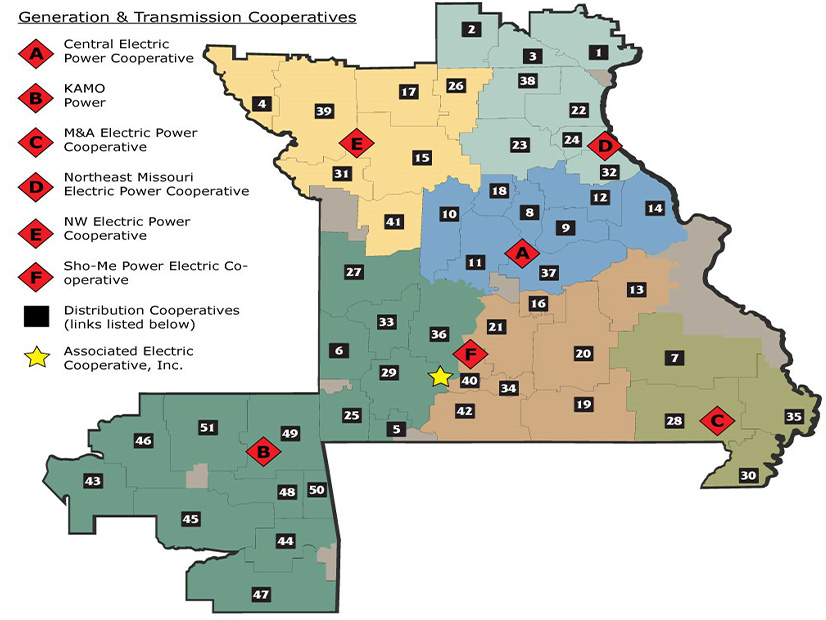
Associated Electric Cooperative Inc. (AECI) will have to pay $42,000 to SERC Reliability for violations of NERC’s reliability standards that lasted more than 15 years, according to a settlement between the utility and the regional entity, approved by FERC at the end of July (NP23-18).
NERC submitted the settlement to FERC in June as the only publicly visible entry in its monthly spreadsheet Notice of Penalty. The ERO also submitted a separate spreadsheet NOP detailing violations of the Critical Infrastructure Protection (CIP) standards, which was not publicly accessible in keeping with NERC’s policy on CIP violations. FERC said in a July 28 filing that it would not further review the settlements, leaving the penalty intact.
AECI provides electricity generation and transmission services through six transmission cooperatives to 51 local electric co-ops in Missouri, Iowa and Oklahoma, serving about 935,000 end customers. Its settlement with SERC stems from six separate instances of noncompliance with reliability standard FAC-009-1 (Establish and communicate facility ratings) and its successor standard FAC-008-5 (Facility ratings), though the NOP did not disclose the precise location of the violations.
The first FAC-009-1 noncompliance came to light in May 2021, when one of AECI’s generation and transmission (G&T) co-ops was reviewing engineering drawings related to a 161 kV network transmission circuit that AECI had recently put back into service after a rebuild project. For this phase of the project, the G&T had told AECI that it would reuse existing bus work and jumpers.
However, the co-op staff later realized that its contractor had replaced a jumper without informing the co-op. The replacement jumper had a larger physical diameter and lower temperature rating than the original, which made it the most limiting element of the transmission circuit and reduced the facility’s capacity by 4%, although the error never caused AECI to exceed the correct rating during the duration of the violation.
After discovering the violation, AECI and the G&T conducted an extent of condition assessment and verified all facility ratings associated with equipment involved in the rebuild project. They did not find the issue in any other location on the AECI transmission system.
AECI later submitted updates to SERC notifying it of five additional noncompliance instances. The utility submitted four of these reports on Feb. 14, 2022, with the last provided that July.
The first of these instances involved the same facility as the original report. A contractor hired by the G&T identified a discrepancy between the substation’s engineering drawings and AECI’s asset management system that incorrectly reported the size of the facility’s bus work, which meant that once again, the wrong piece of equipment was identified as the most limiting factor.
After another extent of condition review, AECI and the G&T determined that no other substations had a similar problem with their bus work.
In the next instance, a G&T identified a switch at a substation with an inaccurate rating in the G&T’s asset management system during a review of spare equipment at certain transmission facilities in August 2021. Another G&T identified five inaccurate ratings in the process of its own spare equipment review that October.
AECI also reported an instance of noncompliance involving its Modeling and Network Transmission Information System (MANTIS) database of transmission equipment. After a G&T reported the equipment it owned at a neighboring utility’s substation in November 2020, AECI discovered that it had not modeled this equipment in MANTIS. However, the team maintaining the database did not update the facility’s ratings until an update nearly a year later.
Finally, AECI and the G&Ts discovered in May 2022 that some G&T personnel were providing relay loadability settings in their asset management systems that differed from those in AECI’s facility ratings methodology. This meant that the ratings for applicable relays were too low.
AECI’s mitigating activities included providing facility ratings awareness material to its associate G&Ts and implementing a process to perform field verifications of relevant substations every five years. As of the filing of the settlement it was in the process of performing the first of these field verifications; it promised to provide quarterly updates to SERC until the process is complete.
SERC assessed the violations as a moderate risk to grid reliability, noting that failing to establish accurate facility ratings creates the risk of operating facilities in excess of their operating limits, although the RE acknowledged that AECI never actually operated its facilities above the correct ratings. SERC awarded the utility credit for self-reporting the violations, for cooperating in the investigation and enforcement process and for agreeing to settle the issue.
However, it also referenced AECI’s compliance history with FAC-008 as an aggravating factor in several of the violations.

